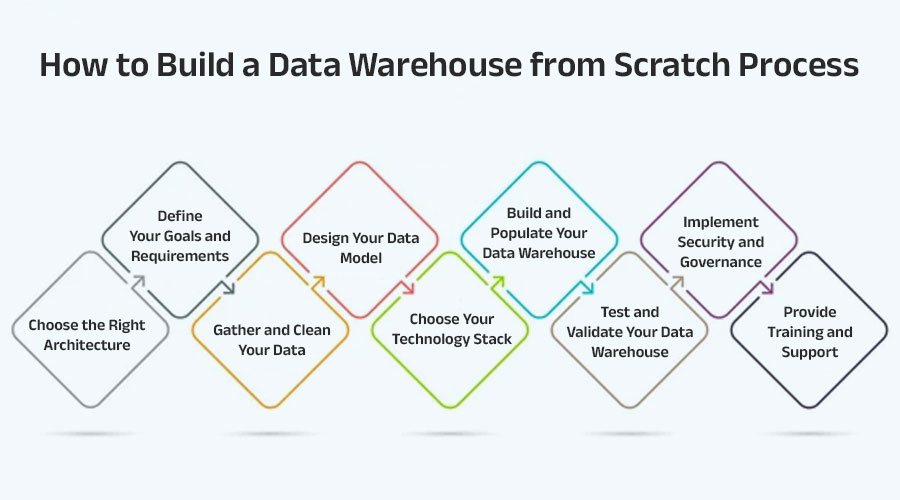Table of Contents
How to Build a Data Warehouse from Scratch Services
In today’s data-driven world, businesses rely heavily on collecting, managing, and analyzing large volumes of data to make informed decisions and gain a competitive edge. A data warehouse serves as the foundation for this process, providing a centralized repository for storing and organizing data from various sources. Building a data warehouse from scratch can be a daunting task, but with careful planning and execution, it can be a rewarding endeavor that yields invaluable insights for your organization. In this guide, we’ll walk you through the essential steps to build a data warehouse from scratch.
- Define Your Objectives: Before diving into the technical aspects of building a data warehouse, it’s crucial to clearly define your objectives and business requirements. Identify the types of data you need to store, the sources from which you’ll be collecting data, and the analytics and reporting capabilities you require. Understanding your goals will help you design a data warehouse that meets your organization’s specific needs.
- Choose the Right Architecture: Selecting the appropriate architecture is critical to the success of your data warehouse project. There are several architectures to choose from, including the traditional Kimball approach and the more modern Inmon approach. Evaluate the pros and cons of each architecture and choose the one that aligns best with your requirements and resources.
- Design Data Model: Next, design a logical data model that reflects the structure of your data warehouse. Identify the entities, attributes, and relationships that will govern your data warehouse schema. Consider factors such as data normalization, denormalization, and dimensional modeling techniques to optimize performance and flexibility.
- Acquire and Prepare Data: Once the data model is in place, it’s time to acquire data from various sources such as transactional databases, CRM systems, ERP systems, and external sources. Implement Extract, Transform, Load (ETL) processes to extract data from source systems, transform it into the appropriate format, and load it into the data warehouse. Cleanse and preprocess the data to ensure accuracy and consistency.
- Implement Data Warehouse Infrastructure: Choose the right infrastructure for your data warehouse, considering factors such as scalability, performance, and cost. You can opt for on-premises solutions, cloud-based solutions, or hybrid approaches depending on your organization’s requirements and preferences. Implement robust security measures to protect sensitive data and ensure compliance with regulations.
- Build Metadata Repository: Establish a metadata repository to manage metadata related to your data warehouse, including data definitions, data lineage, data quality rules, and transformations. A comprehensive metadata repository will provide valuable insights into the structure and lineage of your data, facilitating easier management and governance.
- Enable Data Access and Analytics: Provide users with access to the data warehouse through intuitive dashboards, reporting tools, and analytics platforms. Implement role-based access controls to ensure that users only have access to the data they’re authorized to view. Enable ad-hoc querying and analysis capabilities to empower users to derive actionable insights from the data.
- Monitor and Maintain: Regularly monitor the performance and health of your data warehouse to identify and address any issues proactively. Implement monitoring tools and alerts to track key performance metrics such as query performance, data loads, and storage utilization. Perform regular maintenance tasks such as data backups, index optimizations, and software updates to keep your data warehouse running smoothly.
How to Create a How to Build a Data Warehouse from Scratch
Creating a data warehouse from scratch can be a daunting task, but with careful planning and execution, it can be a rewarding endeavor that provides valuable insights for your organization. A data warehouse is a central repository where data from various sources is stored, integrated, and analyzed to support business decision-making processes. Here’s a step-by-step guide on how to build a data warehouse from scratch:
- Define your objectives: Before you start building your data warehouse, it’s essential to clearly define your objectives and goals. Determine what specific business problems you want to solve and what insights you hope to gain from your data.
- Identify data sources: Next, identify all the data sources within your organization, including databases, spreadsheets, applications, and external sources. This step is crucial for understanding the types of data you’ll be dealing with and how to integrate them into your data warehouse.
- Design your data model: Designing a data model involves defining the structure of your data warehouse, including tables, columns, and relationships between different data entities. Choose a suitable data modeling approach, such as dimensional modeling or normalized modeling, based on your requirements.
- Choose a technology stack: Selecting the right technology stack is crucial for building a robust and scalable data warehouse. Consider factors such as performance, scalability, ease of use, and compatibility with your existing systems. Popular data warehouse technologies include SQL Server, Oracle Database, Amazon Redshift, Google BigQuery, and Snowflake.
- Set up your infrastructure: Once you’ve chosen your technology stack, it’s time to set up the infrastructure for your data warehouse. This may involve provisioning servers, configuring databases, and setting up networking and security measures to ensure data integrity and confidentiality.
- Extract, transform, and load (ETL) data: ETL is the process of extracting data from source systems, transforming it into a format suitable for analysis, and loading it into the data warehouse. Use ETL tools or custom scripts to automate this process and ensure data consistency and quality.
- Implement data governance and security measures: Data governance involves establishing policies and procedures for managing data quality, privacy, and security within your data warehouse. Implement measures such as access controls, encryption, and data masking to protect sensitive information and comply with regulatory requirements.
- Test and validate: Before deploying your data warehouse into production, thoroughly test and validate it to ensure that it meets your requirements and performs as expected. Conduct performance testing, data quality checks, and user acceptance testing to identify and address any issues before they impact your business operations.
- Train users and stakeholders: Provide training and support to users and stakeholders who will be accessing and analyzing data from the data warehouse. Empower them with the knowledge and tools they need to derive meaningful insights and make informed decisions based on the data.
- Monitor and maintain: Once your data warehouse is up and running, monitor its performance and usage regularly to identify any issues or bottlenecks. Implement regular maintenance tasks such as backups, software updates, and performance tuning to keep your data warehouse running smoothly and efficiently.
Why Should You Go for How to Build a Data Warehouse from Scratch
Building a data warehouse from scratch may seem like a daunting task, but it can offer numerous benefits for businesses of all sizes. In today’s data-driven world, having a centralized repository for storing, managing, and analyzing data is crucial for making informed decisions and gaining valuable insights. Here are some compelling reasons why you should consider building a data warehouse from scratch:
- Tailored to Your Business Needs: When you build a data warehouse from scratch, you have the flexibility to design it according to your specific business requirements. You can customize the structure, data models, and integrations to ensure that the data warehouse meets the unique needs of your organization.
- Improved Data Quality: By building a data warehouse from scratch, you have greater control over data quality. You can implement robust data cleansing and validation processes to ensure that the data stored in the warehouse is accurate, consistent, and reliable. This, in turn, enhances the trustworthiness of the insights derived from the data.
- Scalability and Performance: Building a data warehouse from scratch allows you to design a scalable and high-performance solution that can grow with your business. You can choose the appropriate hardware, database technologies, and optimization techniques to ensure that your data warehouse can handle increasing volumes of data and deliver fast query performance.
- Integration with Existing Systems: Building a data warehouse from scratch enables seamless integration with your existing systems and data sources. Whether you’re pulling data from transactional databases, CRM systems, or third-party APIs, you can design the necessary ETL (Extract, Transform, Load) processes to consolidate data into the warehouse efficiently.
- Cost Efficiency: While building a data warehouse from scratch may require upfront investment in terms of time, resources, and expertise, it can ultimately result in cost savings in the long run. By designing a tailored solution that meets your exact needs, you can avoid paying for unnecessary features or expensive vendor lock-in associated with off-the-shelf solutions.
- Enhanced Data Governance and Security: With a custom-built data warehouse, you have greater control over data governance and security policies. You can implement role-based access controls, encryption, and auditing mechanisms to protect sensitive data and ensure compliance with regulations such as GDPR or HIPAA.
- Empowered Decision-Making: By centralizing data from across your organization into a single, unified repository, a data warehouse enables stakeholders to access timely and accurate information for making data-driven decisions. Whether it’s analyzing customer behavior, tracking business performance, or identifying market trends, a well-designed data warehouse empowers decision-makers with actionable insights.
Market Prospects of How to Build a Data Warehouse from Scratch and Platforms
In today’s data-driven world, businesses are constantly looking for ways to harness the power of data to gain insights and make informed decisions. One of the key tools in this endeavor is a data warehouse, which serves as a central repository for storing and analyzing large volumes of data from various sources. Building a data warehouse from scratch can be a daunting task, but with the right approach and platforms, it can also be a highly rewarding investment for any organization.
Market prospects for building a data warehouse from scratch are promising, as businesses across industries recognize the importance of having a robust data infrastructure in place. According to research firm Gartner, the global data warehouse market is expected to grow at a compound annual growth rate (CAGR) of around 8% over the next few years, reaching a value of over $30 billion by 2025.
There are several key factors driving this growth. First and foremost is the exponential growth of data generated by organizations, fueled by trends such as the Internet of Things (IoT), social media, and the increasing digitization of business processes. As the volume, variety, and velocity of data continue to increase, organizations need scalable and flexible data warehouse solutions to handle the influx of information.
Furthermore, businesses are increasingly recognizing the importance of data-driven decision-making in gaining a competitive edge. A well-designed data warehouse allows organizations to consolidate data from disparate sources, analyze it in real-time, and derive valuable insights that can inform strategic decisions. Whether it’s optimizing marketing campaigns, improving operational efficiency, or identifying new revenue opportunities, a data warehouse serves as the foundation for data-driven innovation.
When it comes to building a data warehouse from scratch, organizations have a plethora of platforms and technologies to choose from. Cloud-based solutions such as Amazon Redshift, Google BigQuery, and Microsoft Azure Synapse Analytics offer scalability, flexibility, and cost-effectiveness, making them popular choices for businesses of all sizes. These platforms allow organizations to provision resources on-demand, scale up or down as needed, and leverage advanced analytics capabilities such as machine learning and artificial intelligence.
Alternatively, organizations can opt for on-premises data warehouse solutions, which offer greater control and customization but require significant upfront investment in hardware and infrastructure. Popular on-premises platforms include Oracle Exadata, IBM Netezza, and Teradata, which are favored by large enterprises with complex data needs.
In addition to choosing the right platform, organizations must also consider factors such as data modeling, ETL (extract, transform, load) processes, and data governance when building a data warehouse from scratch. By carefully planning and designing their data warehouse architecture, organizations can ensure scalability, performance, and reliability, setting themselves up for success in the data-driven era.
Essential Features of a How to Build a Data Warehouse from Scratch
Building a data warehouse from scratch can be a daunting task, but with careful planning and attention to essential features, it can be a successful endeavor. A data warehouse is a central repository that stores and integrates data from various sources for analysis and reporting purposes. Whether you are a small business or a large enterprise, understanding the essential features of a data warehouse is crucial for its successful implementation. Below are some key features to consider when building a data warehouse from scratch:
- Data Integration: One of the primary functions of a data warehouse is to integrate data from disparate sources such as transactional databases, CRM systems, ERP systems, spreadsheets, and more. It’s essential to have robust processes in place for extracting, transforming, and loading (ETL) data into the warehouse efficiently.
- Scalability: As your organization grows and generates more data, your data warehouse needs to be scalable to accommodate increasing data volumes. Choose a scalable architecture that can easily expand to meet your future needs without compromising performance.
- Data Quality Management: Maintaining high data quality is crucial for accurate reporting and analysis. Implement data quality management processes to ensure that data is accurate, complete, consistent, and up-to-date. This may involve data cleansing, deduplication, and validation procedures.
- Performance Optimization: Optimize the performance of your data warehouse to ensure fast query response times and efficient data processing. This may involve indexing, partitioning, caching, and other performance tuning techniques.
- Security: Protecting sensitive data is paramount. Implement robust security measures to safeguard your data warehouse against unauthorized access, data breaches, and cyber threats. This may include role-based access control, encryption, authentication mechanisms, and auditing capabilities.
- Data Governance: Establish data governance policies and procedures to ensure that data is managed responsibly and in compliance with regulatory requirements. This may involve defining data ownership, data stewardship roles, data policies, and standards.
- Scalable Architecture: Choose an architecture that suits your organization’s needs and budget. Whether it’s a traditional on-premises data warehouse, a cloud-based solution, or a hybrid approach, ensure that the architecture is scalable, flexible, and cost-effective.
- Support for Analytics: A data warehouse should provide robust support for various analytics and reporting tools. Ensure compatibility with popular BI (business intelligence) tools, data visualization platforms, and analytical languages such as SQL, Python, and R.
- Metadata Management: Implement metadata management capabilities to document and catalog metadata about the data stored in the warehouse. This includes information about data sources, data definitions, data lineage, and data transformations.
- Monitoring and Management: Implement robust monitoring and management capabilities to track the health, performance, and usage of your data warehouse. This includes monitoring resource usage, detecting anomalies, and proactively addressing issues to ensure optimal performance and availability.
Advanced Features of How to Build a Data Warehouse from Scratch
Data warehousing is a critical component of modern business intelligence, enabling organizations to store and analyze large volumes of data to gain insights and make informed decisions. Building a data warehouse from scratch involves several advanced features and considerations to ensure its effectiveness and efficiency. In this article, we will explore some of these advanced features and provide insights into how to implement them effectively.
- Data Modeling: Data modeling is the process of defining the structure of the data warehouse, including its tables, columns, relationships, and constraints. Advanced data modeling techniques, such as dimensional modeling and star schema design, can help optimize query performance and facilitate easy access to data for analysis.
- ETL (Extract, Transform, Load): ETL processes are essential for populating the data warehouse with data from various sources, such as databases, files, and external systems. Advanced ETL tools offer features such as parallel processing, data cleansing, and error handling to ensure the accuracy and reliability of the data.
- Data Quality Management: Maintaining data quality is crucial for ensuring the integrity and reliability of the data warehouse. Advanced data quality management features include data profiling, deduplication, and data validation to identify and address inconsistencies, errors, and anomalies in the data.
- Metadata Management: Metadata provides valuable information about the data stored in the data warehouse, including its source, structure, and meaning. Advanced metadata management tools enable users to capture, catalog, and govern metadata effectively, ensuring data lineage, governance, and compliance.
- Scalability and Performance: As the volume of data grows, scalability and performance become critical considerations for a data warehouse. Advanced features such as distributed processing, partitioning, and indexing can help improve query performance and accommodate growing data volumes efficiently.
- Security and Access Control: Protecting sensitive data and controlling access to the data warehouse are paramount concerns for organizations. Advanced security features, such as role-based access control, encryption, and auditing, help safeguard data against unauthorized access, breaches, and misuse.
- Advanced Analytics: Beyond basic reporting and analysis, advanced analytics capabilities, such as predictive analytics, machine learning, and artificial intelligence, can unlock deeper insights and drive data-driven decision-making. Integrating advanced analytics into the data warehouse enables organizations to uncover hidden patterns, trends, and opportunities in their data.
- Data Governance and Compliance: Establishing robust data governance practices and ensuring compliance with regulatory requirements are essential for maintaining trust and credibility in the data warehouse. Advanced data governance features, such as data lineage tracking, data stewardship, and policy enforcement, help organizations manage data effectively and adhere to industry standards and regulations.
How to Build a Data Warehouse from Scratch Timelines
In today’s data-driven world, businesses rely heavily on accurate and organized data to make informed decisions. A data warehouse plays a crucial role in this process by storing, managing, and analyzing large volumes of data from various sources. Building a data warehouse from scratch can be a daunting task, but with careful planning and execution, it is achievable. In this article, we’ll discuss how to build a data warehouse from scratch, focusing on timelines to ensure a smooth and efficient process.
- Define Objectives and Requirements: Before starting the data warehouse project, it’s essential to clearly define the objectives and requirements. Determine what business questions the data warehouse will answer and what data sources will be integrated into the warehouse. This initial phase may take several weeks to gather input from stakeholders and create a comprehensive project plan.
- Data Modeling and Design: The next step is to design the data model for the warehouse. This involves identifying the entities, attributes, and relationships that need to be represented in the database schema. Use tools like entity-relationship diagrams (ERDs) to visualize the data model and ensure it meets the business requirements. The data modeling phase can take anywhere from a few weeks to a few months, depending on the complexity of the data and the size of the organization.
- Data Extraction and Transformation: Once the data model is finalized, the next step is to extract data from the source systems and transform it into a format suitable for the data warehouse. This process involves cleaning, standardizing, and consolidating data from disparate sources. Develop ETL (Extract, Transform, Load) processes to automate data integration tasks and ensure data quality. Depending on the volume and complexity of the data, this phase may take several months to complete.
- Infrastructure Setup: Building a robust infrastructure for the data warehouse is crucial for performance and scalability. This involves selecting the right hardware and software components, such as database management systems, servers, storage, and networking equipment. Set up the infrastructure according to the requirements identified during the planning phase. This phase may take a few weeks to procure and configure the necessary hardware and software.
- Testing and Quality Assurance: Before deploying the data warehouse into production, thorough testing and quality assurance are essential to ensure its reliability and accuracy. Develop test cases to validate data integrity, performance, and functionality. Conduct various types of testing, including unit testing, integration testing, and user acceptance testing. Address any issues or bugs identified during testing and refine the system accordingly. This phase may take several weeks to complete, depending on the scope of testing.
- Deployment and Implementation: Once testing is complete and the data warehouse is deemed ready for production, it’s time to deploy and implement the system. Plan a phased rollout to minimize disruptions to the business operations. Train end-users and administrators on how to use and maintain the data warehouse effectively. Monitor system performance and address any issues that arise during the initial deployment phase. This phase may take several weeks to complete, depending on the size of the organization and the complexity of the deployment.
- Ongoing Maintenance and Optimization: Building a data warehouse is not a one-time project; it requires ongoing maintenance and optimization to ensure its continued effectiveness. Establish regular monitoring and maintenance routines to identify and address performance bottlenecks, data quality issues, and evolving business requirements. Continuously optimize the data warehouse infrastructure, processes, and queries to improve performance and efficiency. This phase is ongoing and requires dedicated resources to manage and support the data warehouse environment.
How Much Does It Cost to Build a Data Warehouse from Scratch?
Building a data warehouse from scratch can be a significant undertaking for any organization. It involves careful planning, investment in technology and resources, and a thorough understanding of the organization’s data needs. However, the cost of building a data warehouse can vary greatly depending on several factors, including the size and complexity of the data, the technology stack chosen, and whether the project is handled internally or outsourced to a third-party vendor.
- Size and Complexity of Data: The first factor that influences the cost of building a data warehouse is the size and complexity of the data that needs to be stored and analyzed. Larger datasets with diverse sources and formats will require more storage space and processing power, which can increase costs. Additionally, if the data requires extensive cleaning, transformation, and integration before it can be used for analysis, this will also add to the overall cost of the project.
- Technology Stack: The choice of technology stack used to build the data warehouse will also impact the cost. There are various options available, including traditional relational databases, cloud-based data warehouses, and open-source solutions. Each option has its own associated costs for licensing, infrastructure, maintenance, and support. Cloud-based solutions, for example, typically involve subscription-based pricing models where users pay for the resources they consume, while on-premises solutions may require upfront hardware and software investments.
- Internal vs. Outsourced Development: Another consideration is whether the data warehouse project will be developed internally by the organization’s IT team or outsourced to a third-party vendor. Internal development may seem cost-effective initially, but it requires hiring skilled personnel, investing in training, and dedicating resources to the project, all of which can add up over time. Outsourcing the project to a vendor, on the other hand, can provide access to specialized expertise and resources without the need for long-term commitments or upfront investments. However, it’s essential to carefully evaluate the total cost of ownership over the project’s lifecycle when considering outsourcing options.
- Additional Costs: In addition to the direct costs of building the data warehouse, there are also indirect costs to consider, such as ongoing maintenance, upgrades, and support. Data warehouses require regular monitoring, performance tuning, and security updates to ensure optimal performance and data integrity. These ongoing costs should be factored into the overall budget for the project.
How to Create a How to Build a Data Warehouse from Scratch – Team and Tech Stack
Creating a data warehouse from scratch requires careful planning, teamwork, and the right technology stack. A data warehouse is a central repository where businesses store, organize, and analyze large volumes of data from various sources to make informed decisions. Building one involves assembling a skilled team and selecting the appropriate technologies to support your specific needs. Here’s a step-by-step guide on how to build a data warehouse from scratch, focusing on both the team and the technology stack.
- Define your objectives: Before assembling your team or selecting technologies, it’s crucial to understand the purpose of your data warehouse. Determine what insights you want to gain from your data and how it will support your business goals.
- Assemble your team:
- Project Manager: Responsible for overseeing the entire project, coordinating team efforts, and ensuring alignment with business objectives.
- Data Architect: Designs the structure of the data warehouse, including data modeling, schema design, and integration with existing systems.
- Data Engineers: Build and maintain the ETL (Extract, Transform, Load) processes for extracting data from source systems, transforming it into a usable format, and loading it into the data warehouse.
- Database Administrators: Manage the performance, security, and availability of the data warehouse, including backups, updates, and optimizations.
- Business Analysts: Work closely with stakeholders to understand their reporting and analytics requirements, translating them into data warehouse design specifications.
- Data Scientists/Analysts: Use advanced analytics techniques to derive insights from the data stored in the warehouse, helping the organization make data-driven decisions.
- Select your technology stack:
- Database: Choose a database management system (DBMS) suitable for data warehousing, such as PostgreSQL, MySQL, Microsoft SQL Server, or Oracle. Alternatively, consider cloud-based solutions like Amazon Redshift, Google BigQuery, or Snowflake for scalability and flexibility.
- ETL Tools: Select tools for Extracting, Transforming, and Loading data into the warehouse. Popular options include Apache Spark, Informatica, Talend, and Apache NiFi.
- Data Modeling Tools: Utilize tools for designing and visualizing the data warehouse schema and relationships. Examples include ER/Studio, IBM InfoSphere Data Architect, and Lucidchart.
- Analytics and Reporting Tools: Choose platforms for analyzing and visualizing data stored in the warehouse, such as Tableau, Power BI, Looker, or Google Data Studio.
- Data Governance and Security: Implement solutions for managing data quality, ensuring compliance with regulations (e.g., GDPR, CCPA), and securing sensitive information. This may include tools like Collibra, Alation, or Informatica Axon.
- Plan your architecture: Design the architecture of your data warehouse, considering factors such as scalability, performance, reliability, and cost. Decide whether to adopt a traditional on-premises approach, a cloud-based solution, or a hybrid model based on your organization’s requirements and constraints.
- Develop and deploy: Once the team and technology stack are in place, begin developing and deploying the data warehouse according to the defined architecture and specifications. Collaborate closely with stakeholders to ensure that the solution meets their needs and delivers actionable insights.
- Monitor and iterate: Continuously monitor the performance and usage of the data warehouse, collecting feedback from users and stakeholders. Iterate on the design and implementation as necessary to address any issues, optimize performance, and accommodate evolving business requirements.
How to Build a Data Warehouse from Scratch Process
Creating a data warehouse from scratch can be a daunting task, but with the right approach and tools, it can be a rewarding endeavor that provides valuable insights for your organization. A data warehouse is a central repository where data from various sources is stored, organized, and analyzed to support decision-making processes. Here’s a step-by-step guide on how to build a data warehouse from scratch:
- Define Your Goals and Requirements: Before you start building your data warehouse, it’s essential to clearly define your goals and requirements. Determine what data you need to store, analyze, and report on. Consider the types of queries and analyses your users will perform and the scalability and performance requirements of your data warehouse.
- Choose the Right Architecture: There are various data warehouse architectures to choose from, including traditional, cloud-based, and hybrid solutions. Consider factors such as cost, scalability, flexibility, and security when selecting the architecture that best fits your organization’s needs.
- Gather and Clean Your Data: Data is the foundation of any data warehouse, so it’s crucial to gather and clean your data before loading it into the warehouse. This process involves identifying relevant data sources, extracting data from these sources, and transforming and cleaning the data to ensure consistency and accuracy.
- Design Your Data Model: A well-designed data model is essential for organizing and structuring your data warehouse effectively. Start by identifying the entities and attributes you need to store and defining the relationships between them. Consider using dimensional modeling techniques such as star or snowflake schemas for optimal query performance.
- Choose Your Technology Stack: Selecting the right technology stack is critical for building a successful data warehouse. Consider factors such as database management systems, ETL (Extract, Transform, Load) tools, and visualization tools. Popular options include relational databases like PostgreSQL, cloud-based solutions like Amazon Redshift or Google BigQuery, and ETL tools like Apache Spark or Talend.
- Build and Populate Your Data Warehouse: Once you have your architecture, data, data model, and technology stack in place, it’s time to build and populate your data warehouse. Create the necessary tables and schemas based on your data model, and then load your cleaned and transformed data into the warehouse using ETL processes.
- Test and Validate Your Data Warehouse: Testing and validation are essential steps to ensure the accuracy and reliability of your data warehouse. Perform comprehensive testing to verify data integrity, query performance, and system scalability. Validate your data warehouse against business requirements and user expectations to ensure it meets their needs.
- Implement Security and Governance: Security and governance are critical considerations for any data warehouse implementation. Implement robust security measures to protect sensitive data and ensure compliance with relevant regulations such as GDPR or HIPAA. Establish data governance policies and procedures to govern data quality, access controls, and data usage.
- Provide Training and Support: Finally, provide training and support to users who will be accessing and using the data warehouse. Offer training sessions on how to query and analyze data effectively, and provide ongoing support to address any issues or questions that arise.
Next Big Technology – Your Trusted How to Build a Data Warehouse from Scratch Partner
In the rapidly evolving landscape of technology, the need for robust data management solutions has become more critical than ever. As businesses strive to leverage the power of data to drive informed decision-making and gain a competitive edge, the demand for data warehouses continues to grow. A data warehouse serves as a central repository where organizations can consolidate, organize, and analyze vast amounts of data from disparate sources.
Building a data warehouse from scratch requires careful planning, technical expertise, and the right partnership. With the emergence of the next big technologies, such as artificial intelligence, machine learning, and cloud computing, businesses are seeking trusted partners to guide them through the process of building and implementing a data warehouse that meets their unique needs and goals.
At Your Trusted, we understand the challenges businesses face in harnessing the full potential of their data. As your partner in building a data warehouse from scratch, we offer a comprehensive approach that encompasses the following key steps:
- Needs Assessment: We start by understanding your business objectives, data sources, and analytical requirements. Our team works closely with stakeholders to identify key performance indicators (KPIs) and define the scope of the data warehouse project.
- Architecture Design: Based on the needs assessment, we design a scalable and efficient data warehouse architecture that aligns with your business goals. Whether you prefer an on-premises, cloud-based, or hybrid solution, we leverage the latest technologies to ensure optimal performance and flexibility.
- Data Integration: We assist in integrating data from various sources, including internal systems, external databases, and third-party applications. Our experts employ industry-leading ETL (Extract, Transform, Load) tools and techniques to ensure seamless data flow and consistency.
- Data Modeling: Building upon the integrated data, we develop a logical and physical data model tailored to your business requirements. This includes defining dimensions, facts, and relationships to support complex analytics and reporting needs.
- Implementation and Testing: We oversee the implementation of the data warehouse solution and conduct rigorous testing to validate its functionality, performance, and reliability. Our team works diligently to resolve any issues and fine-tune the system for optimal performance.
- Training and Support: As part of our partnership, we provide comprehensive training to your team on using and maintaining the data warehouse effectively. Additionally, we offer ongoing support and maintenance services to ensure the continued success of your data management initiatives.
Enterprise How to Build a Data Warehouse from Scratch
In today’s data-driven world, enterprises are increasingly recognizing the importance of having a robust data warehouse to centralize and analyze their vast amounts of information. Building a data warehouse from scratch can be a daunting task, but with careful planning and execution, it can yield significant benefits in terms of improved decision-making, streamlined operations, and enhanced competitiveness. In this article, we’ll discuss the essential steps and considerations involved in building a data warehouse from scratch for enterprises.
- Define Your Objectives and Requirements: Before embarking on the journey of building a data warehouse, it’s crucial to clearly define your objectives and requirements. Identify the key stakeholders and understand their needs and expectations. Determine the types of data you need to store and analyze, such as sales data, customer information, financial records, and operational metrics. Additionally, consider factors like data volume, velocity, variety, and veracity to ensure that your data warehouse can effectively handle the demands of your enterprise.
- Design Your Data Model: Once you have a clear understanding of your objectives and requirements, the next step is to design your data model. This involves defining the structure of your data warehouse, including the tables, columns, and relationships between different data entities. Choose an appropriate data modeling technique, such as dimensional modeling or entity-relationship modeling, based on your specific needs and use cases. Pay attention to data normalization, denormalization, and indexing to optimize query performance and ensure data integrity.
- Select Your Technology Stack: Selecting the right technology stack is critical to the success of your data warehouse project. Evaluate different options for database management systems (DBMS), ETL (Extract, Transform, Load) tools, and business intelligence (BI) platforms based on factors like scalability, performance, ease of use, and cost-effectiveness. Consider both traditional on-premises solutions and cloud-based services, depending on your budget and IT infrastructure.
- Build and Populate Your Data Warehouse: Once you have finalized your data model and technology stack, it’s time to start building and populating your data warehouse. Begin by setting up the necessary infrastructure and configuring your DBMS according to your data model. Develop ETL processes to extract data from various sources, transform it into a consistent format, and load it into your data warehouse. Pay attention to data quality and cleansing to ensure that your warehouse contains accurate and reliable information.
- Implement Security and Governance Measures: Data security and governance are paramount concerns for enterprises, especially when dealing with sensitive or regulated data. Implement robust security measures to protect your data warehouse against unauthorized access, data breaches, and cyber threats. Define clear policies and procedures for data management, access control, data retention, and compliance with relevant regulations such as GDPR, HIPAA, or PCI DSS.
- Test and Iterate: Once your data warehouse is up and running, it’s essential to thoroughly test its functionality, performance, and reliability. Conduct comprehensive testing to identify and address any issues or bottlenecks, such as data loading errors, query optimization problems, or security vulnerabilities. Iterate on your design and implementation based on feedback from users and stakeholders, continuously refining and improving your data warehouse to meet evolving business needs.
- Provide Training and Support: Finally, provide training and support to users and administrators to ensure that they can effectively use and maintain the data warehouse. Offer training sessions, documentation, and online resources to help users understand how to access and query the data warehouse, interpret the results, and leverage BI tools for reporting and analysis. Establish a support mechanism to address any technical issues or questions that may arise, ensuring that your data warehouse remains a valuable asset for your enterprise.
Top How to Build a Data Warehouse from Scratch Company
In today’s data-driven world, having a robust data warehouse is crucial for businesses to effectively manage and analyze their data. Whether you’re a small startup or a large enterprise, building a data warehouse from scratch requires careful planning and execution. In this guide, we’ll discuss the steps involved in creating a data warehouse and highlight some top companies that specialize in this field.
-
-
Next Big Technology:

Focus Area
- Mobile App Development
- App Designing (UI/UX)
- Software Development
- Web Development
- AR & VR Development
- Big Data & BI
- Cloud Computing Services
- DevOps
- E-commerce Development
Industries Focus
- Art, Entertainment & Music
- Business Services
- Consumer Products
- Designing
- Education
- Financial & Payments
- Gaming
- Government
- Healthcare & Medical
- Hospitality
- Information Technology
- Legal & Compliance
- Manufacturing
- Media
-
- Choose the right technology stack: Selecting the right technology stack is crucial for the success of your data warehouse project. Consider factors such as scalability, performance, security, and ease of integration. Some popular options include cloud-based solutions like Amazon Redshift, Google BigQuery, and Snowflake, as well as on-premises solutions like Microsoft SQL Server and Oracle.
- Design your data model: The next step is to design the data model for your data warehouse. This involves identifying the different data sources, defining the relationships between them, and determining how the data will be structured and organized within the warehouse. Common data modeling techniques include star schema, snowflake schema, and hybrid schema.
- Extract, transform, and load (ETL) data: Once you have your data model in place, you’ll need to extract data from various sources, transform it into a format suitable for analysis, and load it into your data warehouse. This process, known as ETL, is critical for ensuring the accuracy and reliability of your data.
- Test and optimize: Testing and optimization are crucial steps in the data warehouse development process. Thoroughly test your data warehouse to ensure that it’s functioning correctly and producing accurate results. Identify any performance bottlenecks or issues and optimize your system accordingly.
- Implement security measures: Data security is paramount when building a data warehouse. Implement robust security measures to protect sensitive data from unauthorized access, breaches, and other security threats. This may include encryption, access controls, auditing, and monitoring.
- Choose a top data warehouse company: While building a data warehouse from scratch can be a complex and challenging process, many top companies specialize in this field and can provide expert guidance and support. Some of the leading data warehouse companies include IBM, Oracle, Microsoft, Amazon Web Services (AWS), Google Cloud Platform (GCP), and Snowflake.
Add Comparison Table How to Build a Data Warehouse from Scratch
Building a data warehouse from scratch can be a daunting task, but with proper planning and execution, it can be a rewarding endeavor that unlocks valuable insights from your data. In this guide, we will walk you through the steps involved in building a data warehouse from the ground up, and provide insights into the key considerations and best practices along the way.
Understanding the Basics
Before diving into the technical details, it’s essential to have a clear understanding of what a data warehouse is and why it’s important. A data warehouse is a centralized repository that stores structured, historical data from various sources within an organization. It allows for easy access, analysis, and reporting of data, enabling informed decision-making.
Steps to Build a Data Warehouse
- Define Your Objectives: Begin by clearly defining the objectives and goals of your data warehouse project. Identify the types of data you want to store, the insights you hope to gain, and the stakeholders who will benefit from the data warehouse.
- Gather Requirements: Collaborate with stakeholders to gather requirements for the data warehouse. Determine the sources of data, the frequency of data updates, the desired granularity of data, and any specific analytical or reporting needs.
- Design the Schema: Designing the schema is a crucial step in building a data warehouse. Decide on the structure of your database, including the tables, columns, and relationships between them. Common schema designs include star schema and snowflake schema.
- Choose the Right Tools: Selecting the appropriate tools and technologies is essential for the success of your data warehouse project. Consider factors such as scalability, performance, ease of use, and compatibility with your existing infrastructure. Popular options include SQL-based databases like PostgreSQL, cloud-based solutions like Amazon Redshift, and open-source platforms like Apache Hadoop.
- Data Extraction and Transformation: Extract data from various sources, such as transactional databases, CRM systems, and external data sources. Transform the data to conform to the schema of your data warehouse and ensure consistency and quality.
- Load Data into the Warehouse: Once the data has been extracted and transformed, load it into the data warehouse. This process may involve batch loading, real-time streaming, or a combination of both, depending on your requirements.
- Implement Security Measures: Security is paramount when dealing with sensitive data. Implement access controls, encryption, and other security measures to protect your data warehouse from unauthorized access and data breaches.
- Optimize Performance: Continuously monitor and optimize the performance of your data warehouse. Tune queries, index tables, and allocate resources effectively to ensure fast and efficient data retrieval and analysis.
- Provide Access and Training: Grant access to users who need to query and analyze the data warehouse. Provide training and documentation to ensure that users can effectively use the tools and technologies required to interact with the data warehouse.
- Iterate and Improve: Building a data warehouse is an iterative process. Solicit feedback from users, monitor usage patterns, and make adjustments as needed to meet evolving business needs and requirements.
Comparison Table: Popular Data Warehouse Solutions
| Feature | Amazon Redshift | Google BigQuery | Snowflake |
|---|---|---|---|
| Scalability | High | High | High |
| Performance | Good | Excellent | Excellent |
| Pricing | Pay-as-you-go | Pay-as-you-go | Pay-as-you-go |
| Ease of Use | Moderate | Easy | Easy |
| Integration | Good | Good | Good |
| Security | Strong | Strong | Strong |
| SQL Support | Yes | Yes | Yes |
| Real-time Query | Limited | Yes | Yes |
| Data Sharing | Limited | Yes | Yes |
| Managed Service | Yes | Yes | Yes |
FAQs on How to Build a Data Warehouse from Scratch
Building a data warehouse from scratch can be a complex and challenging task, especially for those who are new to the process. However, with the right knowledge and guidance, it is certainly achievable. To help you navigate through the process, here are some frequently asked questions (FAQs) on how to build a data warehouse from scratch:
- What is a data warehouse? A data warehouse is a central repository where businesses store and manage large volumes of structured and unstructured data from various sources. It is designed to support business intelligence (BI) activities such as reporting, analysis, and decision-making.
- Why do I need a data warehouse? Data warehouses enable organizations to consolidate data from different sources, clean and transform it into a consistent format, and make it accessible for analysis. By centralizing data in a data warehouse, businesses can gain valuable insights into their operations, customers, and market trends.
- What are the key components of a data warehouse? The key components of a data warehouse include:
- Extraction, Transformation, and Loading (ETL) tools: These tools are used to extract data from source systems, transform it into a usable format, and load it into the data warehouse.
- Data storage: Data warehouses typically use a relational database management system (RDBMS) to store structured data efficiently.
- Metadata repository: Metadata provides information about the data stored in the warehouse, including its source, meaning, and usage.
- Query and reporting tools: These tools allow users to query and analyze data stored in the warehouse to generate insights and reports.
- What are the steps involved in building a data warehouse? The steps involved in building a data warehouse include:
- Requirement gathering: Identify the business requirements and data sources that need to be incorporated into the warehouse.
- Data modeling: Design the structure of the data warehouse, including tables, relationships, and schemas.
- ETL development: Develop ETL processes to extract, transform, and load data from source systems into the warehouse.
- Data warehouse implementation: Implement the data warehouse using appropriate technologies and tools.
- Testing and validation: Test the data warehouse to ensure data accuracy, consistency, and performance.
- Deployment: Deploy the data warehouse for production use, and provide training to users.
- What are the common challenges in building a data warehouse? Some common challenges in building a data warehouse include:
- Data integration: Integrating data from disparate sources with different formats and structures can be complex and time-consuming.
- Performance optimization: Ensuring that the data warehouse can handle large volumes of data and support fast query processing.
- Data quality: Maintaining data quality and consistency throughout the ETL process.
- Scalability: Designing the data warehouse architecture to scale effectively as data volumes and user requirements grow.
- What are some best practices for building a data warehouse? Some best practices for building a data warehouse include:
- Start with a clear understanding of business requirements and objectives.
- Design a flexible and scalable data model that can accommodate future changes and expansions.
- Use standardized processes and coding conventions for ETL development to maintain consistency and reusability.
- Implement data quality checks and validation processes to ensure the accuracy and reliability of data.
- Regularly monitor and optimize the performance of the data warehouse to meet user requirements.
Thanks for reading our post “How to Build a Data Warehouse from Scratch”. Please connect with us to learn more about the How to Build a Data Warehouse.
















